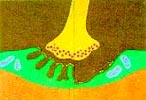What causes Myasthenia Gravis?
Myasthenia Gravis (MG) is all about muscles failing to contract.
Every time your body moves, whether you’re walking, talking or breathing, a muscle contracts. There are three general types of muscles:
- smooth muscle – these are muscles that are not under conscious control, such as the muscles in the walls of the digestive tract;
- skeletal muscle – also known as striated or voluntary muscles, these are the muscles that are attached to parts of the skeleton and are under our voluntary control – we can send messages from the brain to tell the muscle what to do – eg walking and talking; and
- cardiac muscle – the muscles of the heart.
The muscles work by transforming chemical energy into mechanical energy, which moves the human body. In summary, for a muscle to contract, the following must happen:
- an electrical impulse travels from the brain, through the spinal cord down a nerve (the nerves that command the muscle are called motorneurons)
- the nerve ending releases a neurotransmitter substance called acetylcholine (ACh)
- the acetylcholine travels through a small gap between the nerve and the muscle (at the neuromuscular junction) and binds to a protein (receptor) on the surface of the muscle (the muscle membrane) to which the nerve is attached
- resulting in the contraction of that muscle.
It is at the neuromuscular junction (NMJ) where MG does its damage.
We wish to avoid overly technical explanations, but an understanding of how the NMJ works may help you in understanding MG. Wikipedia has an easy to read piece on NMJ at: https://en.wikipedia.org/wiki/Neuromuscular_junction .
In MG, the receptors at the muscle surface are destroyed or deformed by antibodies that prevent a normal musclar reaction from occurring. Antibodies are proteins produced by the immune system to fight infection and disease. With autoimmune diseases such as MG, the body mistakenly sends out antibodies to attack healthy tissue. In MG specifically, the immune system gets triggered to attack an otherwise healthy neuromuscular junction. The antibodies bind to the muscle’s membrane and initiate a series of events that destroy the membrane and prevent ACh from binding. ACh plays a critical role in muscle contraction. When a nerve sends a message telling a muscle to contract, a large amount of ACh is released. If ACh can’t bind to the muscle, the muscle won’t contract.
Nobody quite knows what triggers MG, but around 70% of all myasthenics show evidence of a particular kind of abnormal immune response that is believed to be caused by an abnormal thymus gland (an organ in the chest that plays an essential role in the development of the body’s immune system). Around 15% of all myasthenics have tumours in their thymus , although the tumours are usually benign.
Model of normal neuromuscular junction on top,
compared with myasthenia neuromuscular junction below.


